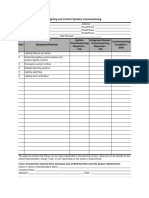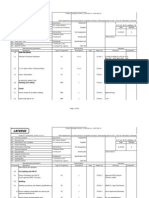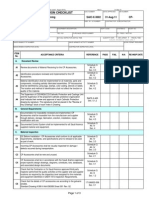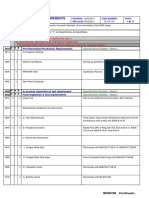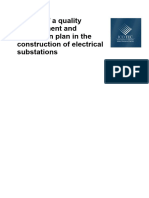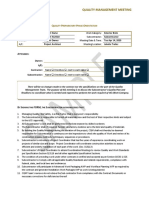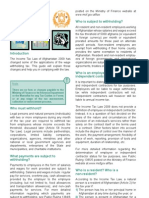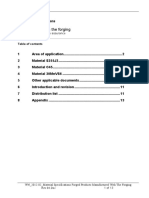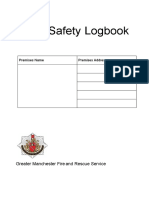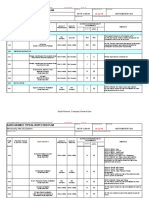Chapter 4 - Contractor Quality Control
Chapter 4 - Contractor Quality Control
Uploaded by
Hamidullah Asady WardakCopyright:
Available Formats
Chapter 4 - Contractor Quality Control
Chapter 4 - Contractor Quality Control
Uploaded by
Hamidullah Asady WardakOriginal Description:
Copyright
Available Formats
Share this document
Did you find this document useful?
Is this content inappropriate?
Copyright:
Available Formats
Chapter 4 - Contractor Quality Control
Chapter 4 - Contractor Quality Control
Uploaded by
Hamidullah Asady WardakCopyright:
Available Formats
Chapter 4, USACE Preconstruction Packet
Chapter 4: Contractor Quality Control
Seattle District, NWS
Last updated: 05FEB14
NWS, Building Strong
Chapter 4, USACE Preconstruction Packet
Chapter 4
Contractor Quality Control
1. GENERAL. Contractor is responsible for quality control and shall establish and maintain an
effective quality control system in compliance with the Contract Clause titled "Inspection of
Construction." The quality control system shall consist of plans, procedures, and organizations
necessary to produce an end product, which complies with the contract requirements.
The following requirements of the “Quality Control System” will aide in a well organized
program that will provide a successful contract for both the Contractor and the Government.
QC’s success or failure at Quality Control of the “Three Phase System” is directly measured in
the CCASS review. The CCASS metrics are provided in Appendix B (ER 415-1-17).
2. CONTROL PLAN: Furnish for Government review, not later than the number of days after
NTP as noted in the contract, the Contractor Quality Control (CQC) Plan. The plan shall identify
personnel, procedures, control, instructions, tests, records, and forms to be used. Design and
construction may begin only after acceptance of the CQC Plan.
3. CONTENT OF THE CQC PLAN: The CQC Plan shall include, as a minimum, the
following to cover all design and construction operations, both onsite and offsite, including work
by subcontractors, fabricators, suppliers, and purchasing agents subcontractors, designers of
record, consultants, architect/engineers (AE), fabricators, suppliers, and purchasing agents:
a. Description of the quality control organization. Include a chart showing lines of authority
and an acknowledgment that the CQC staff shall implement the three phase control system for all
aspects of the work specified.
b. The name, qualifications (in resume format), duties, responsibilities, and authorities of
each person assigned a CQC function. Also include those responsible for performing and
documenting the inspections required by the International Codes and the special inspection
program developed by the designer of record. A copy of the letter to the CQC System Manager,
signed by an authorized official of the firm, which describes the responsibilities and delegates
sufficient authorities to adequately perform the functions of the CQC System Manager, including
authority to stop work which is not in compliance with the contract.
c. Procedures for scheduling, reviewing, certifying, and managing submittals, including those
of subcontractors, offsite fabricators, suppliers, and purchasing agents subcontractors, designers
of record, consultants, architect engineers (AE), offsite fabricators, suppliers, and purchasing
agents. Submittal processes can be found in Chapter 1 of this document.
d. Control, verification, and acceptance testing procedures for each specific test to include the
test name, specification paragraph requiring test, feature of work to be tested, test frequency, and
person responsible for each test. Use only Government approved Laboratory facilities. A list of
all inspections required by the International Codes and the special inspection program required
by the code and this contract.
e. Procedures for tracking preparatory, initial, and follow-up control phases and control,
verification, and acceptance tests including documentation. Procedures for tracking construction
NWS, Building Strong
1
Chapter 4, USACE Preconstruction Packet
deficiencies from identification through acceptable corrective action. These procedures shall
establish verification that identified deficiencies have been corrected. Also, reporting procedures,
including proposed reporting formats.
f. A list of the definable features of work. Although each section of the specifications may
generally be considered as a definable feature of work, there are frequently more than one
definable feature under a particular section. Example: Rough in Plumbing, and Finish plumbing
would have two separate definable features of work for two different preparatory meetings.
g. The Government reserves the right to require the Contractor to make changes in his CQC
Plan and operations including removal of personnel, as necessary, to obtain the quality specified.
h. Notification of Changes: After acceptance of the CQC Plan, notify the Government in
writing of any proposed change. Proposed changes are subject to Government acceptance.
4. COORDINATION MEETING: After the Post Award Conference, before start of design or
construction, and prior to acceptance by the Government of the CQC Plan, the Contractor and
the Government shall meet and discuss the Contractor's quality control system. During the
meeting, a mutual understanding of the system details shall be developed, including the forms for
recording the CQC operations, design activities, control activities, testing, administration of the
system for both onsite and offsite work, and the interrelationship of Contractor's Management
and control with the Government's Quality Assurance. The Government will prepare minutes of
the meeting for signature by both parties. The minutes shall become a part of the contract file.
5. QUALITY CONTROL ORGANIZATION: The requirements for the CQC organization are
a CQC System Manager, and sufficient number of additional qualified personnel to ensure
contract compliance. The CQC organization shall also include personnel identified in the
technical provisions as requiring specialized skills to assure the required work is being
performed properly.
The Contractor's CQC staff shall maintain a presence at the site at all times during progress of
the work and have complete authority and responsibility to take any action necessary to ensure
contract compliance. The CQC staff shall be subject to acceptance by the Contracting Officer.
The CQC organization shall be responsible to maintain all contract required documents and
records at the site at all times, except as otherwise acceptable to the Contracting Officer.
6. CQC SYSTEM MANAGER: An individual within the onsite work organization that shall be
responsible for overall management of CQC and have the authority to act in all CQC matters for
the Contractor. The CQC System Manager will meet all of the contract requirements for
education, training and experience for this position. The CQC System Manager shall be on the
site at all times during construction and shall be employed by the prime Contractor. Assign the
CQC System Manager no other duties. The requirements for the alternate shall be the same as for
the designated CQC System Manager but the alternate may have other duties in addition to
serving in a temporary capacity as the acting QC manager. CQC System Manager shall have
completed the course entitled "Construction Quality Management for Contractors."
Organizational Changes: When it is necessary to make changes to the CQC staff, the Contractor
shall revise the CQC Plan to reflect the changes and submit the changes to the Contracting
Officer for acceptance.
NWS, Building Strong
2
Chapter 4, USACE Preconstruction Packet
7. CONTROL: Contractor Quality Control is the means by which the Contractor ensures that
the construction, to include that of subcontractors and suppliers, complies with the requirements
of the contract. The CQC organization shall conduct at least three phases of control for each
definable feature of the construction work as follows:
Three Phase Reporting System:
8. PREPARATORY: Perform this phase prior to beginning work on each definable feature of
work, after all required plans/documents/materials are approved/accepted, and after copies are at
the work site. See Figure 4-1 for a QCS generated Preparatory Control Phase Worksheet. This
phase shall include:
a. A review of each paragraph of applicable specifications, reference codes, and standards.
Make a copy of those sections of referenced codes and standards applicable to that portion of the
work to be accomplished in the field at the preparatory inspection. Maintain these copies in the
field, available for use by Government personnel until final acceptance of the work.
b. Review of the contract drawings.
c. A check to assure that all materials and/or equipment have been tested, submitted, and
approved.
d. Review of provisions that have been made to provide required control inspection and
testing.
e. Examination of the work area to assure that all required preliminary work has been
completed and is in compliance with the contract.
f. A physical examination of required materials, equipment, and sample work to assure that
they are on hand, conform to approved shop drawings or submitted data, and are properly stored.
g. A review of the appropriate activity hazard analysis to assure safety requirements are met.
Review the activity analysis with each worker and have them sign the AHA. AHA requirements
can be found in Chapter 5 of this document. Discuss Accident Reporting with the contractor and
review Chapter 5 of this document for procedures.
h. Discussion of procedures for controlling quality of the work including repetitive
deficiencies. Document construction tolerances and workmanship standards for that feature of
work.
i. A check to ensure that the portion of the plan for the work to be performed has been
accepted by the Contracting Officer.
j. Discussion of the initial control phase.
NWS, Building Strong
3
Chapter 4, USACE Preconstruction Packet
k. Prior notification to the Government is required for the Preparatory Meeting. This meeting
shall be conducted by the CQC System Manager and attended by the superintendent, SSHO and
other CQC personnel (as applicable), and the foreman responsible for the definable feature.
Document the results of the preparatory phase actions by separate minutes prepared by the CQC
System Manager and attached to the daily CQC report. The Contractor shall instruct applicable
workers as to the acceptable level of workmanship required in order to meet contract
specifications.
l. Review all RFIs associated with the definable feature of work.
m. Review all modifications associated the definable feature of work.
9. INITIAL: Accomplish this phase at the beginning of a definable feature of work. See Figure
4-2 for a QCS generated Initial Control Phase Worksheet. Include the following actions:
a. Check work to ensure that it is in full compliance with contract requirements. Review
minutes of the preparatory meeting.
b. Verify adequacy of controls to ensure full contract compliance. Verify required control
inspection and testing. Resolve all differences and deficiencies.
c. Establish level of workmanship and verify that it meets minimum acceptable workmanship
standards. Compare with required sample panels as appropriate.
d. Check safety to include compliance with and upgrading of the Accident Prevention plan
and activity hazard analysis. Review the activity analysis with each worker. Particular attention
should be given to high hazard work.
e. Prior notification to the Government is required for Initial Phase meeting. The CQC
System Manager shall prepare and attach to the daily CQC report separate minutes of this phase.
f. Repeat the initial phase any time acceptable specified quality standards are not being met.
10. FOLLOW UP: Perform daily checks to assure control activities, including control testing,
are providing continued compliance with contract requirements, until completion of the
particular feature of work. The checks shall be made a matter of record in the CQC
documentation. Conduct final follow-up checks and correct deficiencies prior to the start of
additional features of work which may be affected by the deficient work. Do not build upon nor
conceal non-conforming work.
11. TESTS: Testing Procedure: Perform specified or required tests to verify that control
measures are adequate to provide a product which conforms to contract requirements and project
design documents. Upon request, furnish to the Government duplicate samples of test specimens
for possible testing by the Government. Testing includes operation and/or acceptance tests when
specified. The Contractor shall procure the services of a Corps of Engineers approved testing
laboratory, or establish an approved testing laboratory at the project site.
NWS, Building Strong
4
Chapter 4, USACE Preconstruction Packet
a. Verify that testing procedures comply with contract requirements and project design
documents.
b. Verify that facilities and testing equipment are available and comply with testing
standards.
c. Check test instrument calibration data against certified standards.
d. Verify that recording forms and test identification control number system, including all of
the test documentation requirements, have been prepared.
e. Include results of all tests taken, both passing and failing tests, recorded on the CQC report
for the date taken. Include specification paragraph reference, location where tests were taken,
and the sequential control number identifying the test. If approved by the Contracting Officer,
actual test reports may be submitted later with a reference to the test number and date taken.
Provide an information copy of tests performed by an offsite or commercial test facility directly
to the Contracting Officer. Failure to submit timely test reports as stated may result in
nonpayment for related work performed and disapproval of the test facility for this contract.
12. COMPLETION INSPECTION:
a. Punch-Out Inspection: CQC Manager shall conduct an inspection of the work. Prepare a
punch list of items which do not conform to the approved drawings and specifications and
include in the CQC documentation, as required by paragraph “DOCUMENTATION.” The list of
deficiencies shall include the estimated date by which the deficiencies will be corrected. The
CQC System Manager or staff shall make a second inspection to ascertain that all deficiencies
have been corrected. Once this is accomplished, the Contractor shall notify the Government that
the facility is ready for the Government Pre-Final inspection.
b. Pre-Final Inspection: As soon as practicable after the notification above, the Government
will perform the pre-final inspection to verify that the facility is complete and ready to be
occupied. A Government Pre-Final Deficiency List may be developed as a result of this
inspection. The Contractor's CQC System Manager shall ensure that all items on this list have
been corrected before notifying the Government, so that a Final inspection with the customer can
be scheduled.
c. Final Acceptance Inspection: The Contractor's Quality Control Inspection personnel, plus
the superintendent or other primary management person, and the Contracting Officer's
Representative shall attend the final acceptance inspection. Additional Government personnel
including, but not limited to, those from Base/Post Civil Facility Engineer user groups and major
commands may also attend. The Government will formally schedule the final acceptance
inspection based upon results of the Pre-Final inspection. Provide notice to the Government at
least 14 days prior to the final acceptance inspection and include the Contractor's assurance that
all specific items previously identified to the Contractor as being unacceptable, along with all
NWS, Building Strong
5
Chapter 4, USACE Preconstruction Packet
remaining work performed under the contract, will be complete and acceptable by the date
scheduled for the final acceptance inspection.
13. DOCUMENTATION: Maintain current records providing factual evidence that required
quality control activities and/or tests have been performed. These records shall include the work
of subcontractors and suppliers. The report includes, as a minimum, the following information:
a. Contractor/subcontractor and their area of responsibility.
b. Operating plant/equipment with hours worked, idle, or down for repair.
c. Work performed each day. Include work location, description, and by whom. When
Network Analysis (NAS) is used, identify each phase of work performed each day by NAS
activity number.
d. Test and/or control activities performed with results and references to
specifications/drawings requirements. Identify the applicable control phase (Preparatory, Initial,
Follow-up) for this report. List deficiencies noted, along with corrective action.
e. Quantity of materials received at the site with statement as to acceptability, storage, and
reference to specifications/drawings requirements.
f. Submittals and deliverables reviewed, with contract reference, by whom, and action taken.
g. Offsite surveillance activities, including actions taken.
h. Job safety evaluations stating what was checked, results, and instructions or corrective
actions.
i. Instructions given/received and conflicts in plans and/or specifications.
14. CONTRACTOR'S VERIFICATION STATEMENT: These records shall indicate a
description of trades working on the project; the number of personnel working; weather
conditions encountered; and any delays encountered. These records shall cover both conforming
and deficient features and shall include a statement that equipment and materials incorporated in
the work and workmanship comply with the contract. Furnish the original and one copy of these
records in report form to the Government daily within 24 hours after the date covered by the
report, except that reports need not be submitted for days on which no work is performed. As a
minimum, submit one report for every 7 days of no work and on the last day of a no work period.
Account for all calendar days throughout the life of the contract. The first report following a day
of no work shall be for that day only. The CQC System Manager shall sign and date reports. The
report shall include copies of test reports and copies of reports prepared by all subordinate
quality control personnel. The Contractor may submit these forms electronically, in lieu of hard
copy.
NWS, Building Strong
6
Chapter 4, USACE Preconstruction Packet
15. NOTIFICATION OF NONCOMPLIANCE: The Contracting Officer will notify the
Contractor of any detected noncompliance with the foregoing requirements. The Contractor shall
take immediate corrective action after receipt of such notice. Such notice, when delivered to the
Contractor at the work site, shall be deemed sufficient for the purpose of notification. If the
Contractor fails or refuses to comply promptly, the Contracting Officer may issue an order
stopping all or part of the work until satisfactory corrective action has been taken. No part of the
time lost due to such stop orders shall be made the subject of claim for extension of time or for
excess costs or damages by the Contractor.
16. QUALITY CONTROL SYSTEM (QCS): The Government will use the Resident
Management System for Windows (RMS) to assist in its monitoring and administration of this
contract. The Contractor shall use the Government-furnished Construction Contractor Module of
RMS, referred to as QCS, to record, maintain, and submit information throughout the contract
period. The Contractor module, user manuals, updates, and training information can be
downloaded from the RMS web site. This joint Government-Contractor use of RMS and QCS
will facilitate electronic exchange of information and overall management of the contract. QCS
provides the means for the Contractor to input, track, and electronically share information with
the Government. See Figure 4-3 for an RMS generated Deficiency Log and Figure 4-4 for an
RMS generated QC Daily Report.
QCS USER GUIDE: After contract award, the Contractor shall download instructions for the
installation and use of QCS from the Government RMS Internet Website. In case of justifiable
difficulties, the Government will provide the Contractor with a CD-ROM containing these
instructions.
17. REQUEST FOR INFORMATION: The Government requires the use of RMS/QCS to log
official Requests For Information (RFI). See Figure 4-5 for an example form. Insure the RFI
submitter completes all sections of the form. All RFI submittals should be able to explain the
discrepancy on their own and should not rely on previous conversations or knowledge not
relayed in the RFI. A complete RFI references the specific contract item(s) of concern, explains
the question, provides recommended solution(s) and recognizes whether that suggested solution
carries a cost or time impact from the contractor’s viewpoint. In doing this, the contractor should
include all drawings and specification description and any attachments required to explain the
question/discrepancy.
This level of detail is required because RFIs are often answered by the Designer of Record or
another subject matter expert that may not be involved in the day to day operations of the project.
NWS, Building Strong
7
Chapter 4, USACE Preconstruction Packet
18. SUBMITTALS: Procedures for scheduling, reviewing, certifying, and managing submittals,
including those of subcontractors, offsite fabricators, suppliers, and purchasing agents. These
procedures must be in accordance with Contract Specification Section SUBMITTAL
PROCEDURES, and Chapter 1 of this document. Maintaining a complete and updated Submittal
system is paramount in a successful Quality Control System.
Enclosures
Figure 4-1 Preparatory Control Phase Worksheet
Figure 4-2 Initial Control Phase Worksheet
Figure 4-3 Deficiency Log
Figure 4-4 RMS Sample QC Daily Report
Figure 4-5 RMS Sample Request for Information (RFI)
NWS, Building Strong
8
You might also like
- Section 01 91 00 - General Commissioning Requirements Part 1 - GeneralNo ratings yetSection 01 91 00 - General Commissioning Requirements Part 1 - General20 pages
- Lighting and Control Systems CommissioningNo ratings yetLighting and Control Systems Commissioning1 page
- GuideBook For Site Inspection - 20090401No ratings yetGuideBook For Site Inspection - 20090401151 pages
- 014 - G.I Duct, Accessories and FittingsNo ratings yet014 - G.I Duct, Accessories and Fittings14 pages
- QM-R83-PL-4051 Procedure For Concrete Surface Preparation and Coating Rev. 01No ratings yetQM-R83-PL-4051 Procedure For Concrete Surface Preparation and Coating Rev. 0111 pages
- MS For Removal and Reinstatement of Wind Dust BarrierNo ratings yetMS For Removal and Reinstatement of Wind Dust Barrier7 pages
- QA QC Electrical and Instrument EngineerNo ratings yetQA QC Electrical and Instrument Engineer4 pages
- Saudi Aramco Inspection Checklist: Level - Magnetic Gauges / Switches-Material Receiving. SAIC-J-6302 1-Oct-05 InstNo ratings yetSaudi Aramco Inspection Checklist: Level - Magnetic Gauges / Switches-Material Receiving. SAIC-J-6302 1-Oct-05 Inst2 pages
- MS-ELECTRICAL-EMBEDDED CONDUIT and FITTINGS FinalNo ratings yetMS-ELECTRICAL-EMBEDDED CONDUIT and FITTINGS Final9 pages
- Red Bag Checklist For Mechanical CompletionNo ratings yetRed Bag Checklist For Mechanical Completion9 pages
- DC2-ECI-CNP-MST-ME-005 - Method Statement For Operational Test of Water Flow Meter.100% (1)DC2-ECI-CNP-MST-ME-005 - Method Statement For Operational Test of Water Flow Meter.20 pages
- MS For Instrumentation Cabinet, Panel, Rack & JBNo ratings yetMS For Instrumentation Cabinet, Panel, Rack & JB13 pages
- Specification: Commissioning - Transitioning Assets Into Operation100% (1)Specification: Commissioning - Transitioning Assets Into Operation77 pages
- Laying & Testing of Fire Detection Cable Methods Statement100% (1)Laying & Testing of Fire Detection Cable Methods Statement23 pages
- Saudi Aramco Test Report: SATR-P-3106 Elect-UPS Static Switch, Pre-Commissioning & Functional TestingNo ratings yetSaudi Aramco Test Report: SATR-P-3106 Elect-UPS Static Switch, Pre-Commissioning & Functional Testing10 pages
- Method Statement For Installation of Fan Coil UnitNo ratings yetMethod Statement For Installation of Fan Coil Unit4 pages
- SECTION 01 91 00 General Commissioning Requirements Part 1 - General 1.1 Commissioning DescriptionNo ratings yetSECTION 01 91 00 General Commissioning Requirements Part 1 - General 1.1 Commissioning Description74 pages
- Installation, Testing & Flushing of Firefighting Piping System - Method Statement HQ100% (1)Installation, Testing & Flushing of Firefighting Piping System - Method Statement HQ20 pages
- Commissioning Requirements 03/02 01810 - 1 OF 20 D:/DOCS/DIV1/03-02/01810No ratings yetCommissioning Requirements 03/02 01810 - 1 OF 20 D:/DOCS/DIV1/03-02/0181020 pages
- Section 15330 - Wet-Pipe Sprinkler SystemsNo ratings yetSection 15330 - Wet-Pipe Sprinkler Systems34 pages
- QCS-2010 Section 19 Part 6 Commissioning of SystemsNo ratings yetQCS-2010 Section 19 Part 6 Commissioning of Systems6 pages
- Inspection & Testing Requirements Scope:: Test and Inspection PerNo ratings yetInspection & Testing Requirements Scope:: Test and Inspection Per2 pages
- SATIP-P-104-03 Rev 3 Cable Tray Fittings and Accessories100% (1)SATIP-P-104-03 Rev 3 Cable Tray Fittings and Accessories3 pages
- Method of Statement For Installation of Wires and Cables PDF FreeNo ratings yetMethod of Statement For Installation of Wires and Cables PDF Free6 pages
- Quality Management Plan For Construction of Electrical SubstationsNo ratings yetQuality Management Plan For Construction of Electrical Substations67 pages
- Method Statement For Testing and Commissioning of MDB, SMDB, DB, MCC & CBNo ratings yetMethod Statement For Testing and Commissioning of MDB, SMDB, DB, MCC & CB11 pages
- Inspection & Testing Requirements Scope:: Test and Inspection PerNo ratings yetInspection & Testing Requirements Scope:: Test and Inspection Per2 pages
- MS For Chipping and Concrete Works On GIS Zone-C Ground Floor Slab For Missing OpeningsNo ratings yetMS For Chipping and Concrete Works On GIS Zone-C Ground Floor Slab For Missing Openings8 pages
- Guide To Effective Contractor Quality ControlNo ratings yetGuide To Effective Contractor Quality Control15 pages
- Top 10 Primavera Interview Questions and Model AnswersNo ratings yetTop 10 Primavera Interview Questions and Model Answers11 pages
- Common Interview Questions For Planning EngineerNo ratings yetCommon Interview Questions For Planning Engineer24 pages
- Products Affected / Serial Numbers Affected:: TP10 003a.pdf 03-02-10No ratings yetProducts Affected / Serial Numbers Affected:: TP10 003a.pdf 03-02-102 pages
- Network Protection & Automation Guide - NPAG 2011 Alstom100% (1)Network Protection & Automation Guide - NPAG 2011 Alstom508 pages
- Analysis of Earth Dam Using ANSYS & Geostudio100% (1)Analysis of Earth Dam Using ANSYS & Geostudio8 pages
- F07 - RFA - Form No. AC-PR-NCR-01-F07 Dated 15.06.2017 30No ratings yetF07 - RFA - Form No. AC-PR-NCR-01-F07 Dated 15.06.2017 302 pages
- On-Site Assessment Report: Lomé Container Terminal S.A. Route A3 D'akodessewa (Zone Portuaire) 09 BP 9103 Lomé, TogoNo ratings yetOn-Site Assessment Report: Lomé Container Terminal S.A. Route A3 D'akodessewa (Zone Portuaire) 09 BP 9103 Lomé, Togo128 pages
- Material Specifications Forged Products Manufactured With The Forging Rev.04No ratings yetMaterial Specifications Forged Products Manufactured With The Forging Rev.0413 pages
- Estimation of Residual Pipeline Life Based On In-Line Inspection DataNo ratings yetEstimation of Residual Pipeline Life Based On In-Line Inspection Data11 pages
- Indian Railways: Ref: CG-WI-4.2.1-1 Ver.-1.0 Page 1 of 14 Date of Issue October 2018 Spec. NoNo ratings yetIndian Railways: Ref: CG-WI-4.2.1-1 Ver.-1.0 Page 1 of 14 Date of Issue October 2018 Spec. No14 pages
- Engineering Encyclopedia: Fabrication, Inspection, and Testing of Heat Exchangers100% (1)Engineering Encyclopedia: Fabrication, Inspection, and Testing of Heat Exchangers31 pages
- Bridge Design Manual: Washington State Department of TransportationNo ratings yetBridge Design Manual: Washington State Department of Transportation59 pages
- Fire Safety Logbook: Greater Manchester Fire and Rescue ServiceNo ratings yetFire Safety Logbook: Greater Manchester Fire and Rescue Service18 pages
- Process Acceptance Sign Off Sheet Dec 2011No ratings yetProcess Acceptance Sign Off Sheet Dec 20111 page
- ASTM A 802 Standard Practice For Steel Castings, Iron Castings, Surface Acceptance, Visual Examination100% (1)ASTM A 802 Standard Practice For Steel Castings, Iron Castings, Surface Acceptance, Visual Examination10 pages
- PCA Dryer Can Inspection Requirements (Rev 5)No ratings yetPCA Dryer Can Inspection Requirements (Rev 5)7 pages
- Uic Code: Technical Specification For The Supply of Rough Rolled Non-Alloy Steel Tyres For Tractive and Trailing StockNo ratings yetUic Code: Technical Specification For The Supply of Rough Rolled Non-Alloy Steel Tyres For Tractive and Trailing Stock39 pages
- l1 - l2 Practical Exam Instructions and Generic Welding Standard - English 2022No ratings yetl1 - l2 Practical Exam Instructions and Generic Welding Standard - English 20223 pages
- Section 01 91 00 - General Commissioning Requirements Part 1 - GeneralSection 01 91 00 - General Commissioning Requirements Part 1 - General
- QM-R83-PL-4051 Procedure For Concrete Surface Preparation and Coating Rev. 01QM-R83-PL-4051 Procedure For Concrete Surface Preparation and Coating Rev. 01
- MS For Removal and Reinstatement of Wind Dust BarrierMS For Removal and Reinstatement of Wind Dust Barrier
- Saudi Aramco Inspection Checklist: Level - Magnetic Gauges / Switches-Material Receiving. SAIC-J-6302 1-Oct-05 InstSaudi Aramco Inspection Checklist: Level - Magnetic Gauges / Switches-Material Receiving. SAIC-J-6302 1-Oct-05 Inst
- DC2-ECI-CNP-MST-ME-005 - Method Statement For Operational Test of Water Flow Meter.DC2-ECI-CNP-MST-ME-005 - Method Statement For Operational Test of Water Flow Meter.
- Specification: Commissioning - Transitioning Assets Into OperationSpecification: Commissioning - Transitioning Assets Into Operation
- Laying & Testing of Fire Detection Cable Methods StatementLaying & Testing of Fire Detection Cable Methods Statement
- Saudi Aramco Test Report: SATR-P-3106 Elect-UPS Static Switch, Pre-Commissioning & Functional TestingSaudi Aramco Test Report: SATR-P-3106 Elect-UPS Static Switch, Pre-Commissioning & Functional Testing
- Method Statement For Installation of Fan Coil UnitMethod Statement For Installation of Fan Coil Unit
- SECTION 01 91 00 General Commissioning Requirements Part 1 - General 1.1 Commissioning DescriptionSECTION 01 91 00 General Commissioning Requirements Part 1 - General 1.1 Commissioning Description
- Installation, Testing & Flushing of Firefighting Piping System - Method Statement HQInstallation, Testing & Flushing of Firefighting Piping System - Method Statement HQ
- Commissioning Requirements 03/02 01810 - 1 OF 20 D:/DOCS/DIV1/03-02/01810Commissioning Requirements 03/02 01810 - 1 OF 20 D:/DOCS/DIV1/03-02/01810
- QCS-2010 Section 19 Part 6 Commissioning of SystemsQCS-2010 Section 19 Part 6 Commissioning of Systems
- Inspection & Testing Requirements Scope:: Test and Inspection PerInspection & Testing Requirements Scope:: Test and Inspection Per
- SATIP-P-104-03 Rev 3 Cable Tray Fittings and AccessoriesSATIP-P-104-03 Rev 3 Cable Tray Fittings and Accessories
- Method of Statement For Installation of Wires and Cables PDF FreeMethod of Statement For Installation of Wires and Cables PDF Free
- Quality Management Plan For Construction of Electrical SubstationsQuality Management Plan For Construction of Electrical Substations
- Method Statement For Testing and Commissioning of MDB, SMDB, DB, MCC & CBMethod Statement For Testing and Commissioning of MDB, SMDB, DB, MCC & CB
- Inspection & Testing Requirements Scope:: Test and Inspection PerInspection & Testing Requirements Scope:: Test and Inspection Per
- MS For Chipping and Concrete Works On GIS Zone-C Ground Floor Slab For Missing OpeningsMS For Chipping and Concrete Works On GIS Zone-C Ground Floor Slab For Missing Openings
- Top 10 Primavera Interview Questions and Model AnswersTop 10 Primavera Interview Questions and Model Answers
- Products Affected / Serial Numbers Affected:: TP10 003a.pdf 03-02-10Products Affected / Serial Numbers Affected:: TP10 003a.pdf 03-02-10
- Network Protection & Automation Guide - NPAG 2011 AlstomNetwork Protection & Automation Guide - NPAG 2011 Alstom
- F07 - RFA - Form No. AC-PR-NCR-01-F07 Dated 15.06.2017 30F07 - RFA - Form No. AC-PR-NCR-01-F07 Dated 15.06.2017 30
- On-Site Assessment Report: Lomé Container Terminal S.A. Route A3 D'akodessewa (Zone Portuaire) 09 BP 9103 Lomé, TogoOn-Site Assessment Report: Lomé Container Terminal S.A. Route A3 D'akodessewa (Zone Portuaire) 09 BP 9103 Lomé, Togo
- Material Specifications Forged Products Manufactured With The Forging Rev.04Material Specifications Forged Products Manufactured With The Forging Rev.04
- Estimation of Residual Pipeline Life Based On In-Line Inspection DataEstimation of Residual Pipeline Life Based On In-Line Inspection Data
- Indian Railways: Ref: CG-WI-4.2.1-1 Ver.-1.0 Page 1 of 14 Date of Issue October 2018 Spec. NoIndian Railways: Ref: CG-WI-4.2.1-1 Ver.-1.0 Page 1 of 14 Date of Issue October 2018 Spec. No
- Engineering Encyclopedia: Fabrication, Inspection, and Testing of Heat ExchangersEngineering Encyclopedia: Fabrication, Inspection, and Testing of Heat Exchangers
- Bridge Design Manual: Washington State Department of TransportationBridge Design Manual: Washington State Department of Transportation
- Fire Safety Logbook: Greater Manchester Fire and Rescue ServiceFire Safety Logbook: Greater Manchester Fire and Rescue Service
- ASTM A 802 Standard Practice For Steel Castings, Iron Castings, Surface Acceptance, Visual ExaminationASTM A 802 Standard Practice For Steel Castings, Iron Castings, Surface Acceptance, Visual Examination
- Uic Code: Technical Specification For The Supply of Rough Rolled Non-Alloy Steel Tyres For Tractive and Trailing StockUic Code: Technical Specification For The Supply of Rough Rolled Non-Alloy Steel Tyres For Tractive and Trailing Stock
- l1 - l2 Practical Exam Instructions and Generic Welding Standard - English 2022l1 - l2 Practical Exam Instructions and Generic Welding Standard - English 2022








